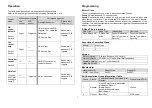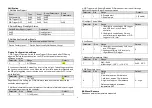
8
exclusion mode.
Factory Reset
(This procedure
should only be
used when the
controller is
inoperable.)
1. Press the Link button 3 times within
1.5 seconds to put the unit into
exclusion mode.
2. Within 1 second of step 1, press
the Link button again and hold until
LED is off (about 5 seconds).
3. Node ID is excluded. The device
reverts to factory default state and
will be in auto-inclusion mode for 4
minutes.
Failure or success in Inclusion/Exclusion can be viewed on the Z-Wave
Controller user interface.
Specifications
PIR Tilting Angle
140°
Mounting Height
Recommended 2.0 ~ 3.0m height on normal brick
wall
PIR Detection area
Max. distance 20m, max. angle of 120°
(@2.0m height, 68°F ambient temperature)
PIR Swivel Angle
Up to 90° Leftward, Up to 90° Rightward
PIR warm-up time
Approx. 60 seconds
Lux Adjustment
Approximately 10 ~ 900 Lux
Timer Adjustment
Approximately 8 seconds ~ 12 minutes
Working Temperature
-4°F - +104°F
Dimension (H x W x D)
60mm x 55mm x 60mm
Protection Degree
IP44
– Weather proof
Specifications are subject to change without notice
Federal Communication Commission Interference Statement
This equipment has been tested and found to comply with the limits for a Class B
digital device, pursuant to Part 15 of the FCC Rules. These limits are designed
to provide reasonable protection against harmful interference in a residential
installation. This equipment generates, uses and can radiate radio frequency
energy and, if not installed and used in accordance with the instructions, may
cause harmful interference to radio communications. However, there is no
guarantee that interference will not occur in a particular installation. If this
equipment does cause harmful interference to radio or television reception, which
can be determined by turning the equipment off and on, the user is encouraged to
try to correct the interference by one of the following measures:
-
Reorient or relocate the receiving antenna.
-
Increase the separation between the equipment and receiver.
-
Connect the equipment into an outlet on a circuit different from that to which
the receiver is connected.
-
Consult the dealer or an experienced radio/TV technician for help.
Un-license band:
This device complies with Part 15 of the FCC Rules. Operation
is subject to the following two conditions: (1) This device may not cause harmful
interference, and (2) this device must accept any interference received, including
interference that may cause undesired operation.
FCC Caution: Any changes or modifications not expressly approved by the party
responsible for compliance could void the user's authority to operate this
equipment.
This transmitter must not be co-located or operating in conjunction with any other
antenna or transmitter.
1.To comply with FCC RF exposure compliance requirements, a separation
distance of at least 20 cm must be maintained between the antenna of this device
and all persons.
2. This Transmitter must not be co-located or operating in conjunction with any
other antenna or transmitter
WARNING:
Do not dispose of electrical appliances as unsorted municipal waste, use separate
collection facilities.
Contact your local government for information regarding the collection systems
available.
If electrical appliances are disposed of in landfills or dumps, hazardous
substances can leak into the groundwater and get into the food chain, damaging
your health and well-being.
When replacing old appliances with new ones, the retailer is legally obligated to
take back your old appliance for disposal at least for free of charge.
Need help?
Be sure to visit our website for the most up-to-date information about this product:
https://homeseer.com/support-home/

























